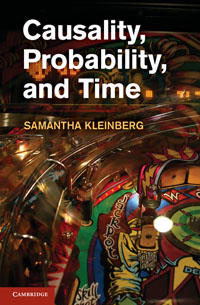Causality, Probability and Time by Dr. Samantha Kelinberg is a whirlwind yet original journey of the interdisciplinary study of probabilistic temporal logic and causal inference. Probabilistic causation is a fairly demanding area of study which studies the relationship between cause and effect using the tools of probability theory. Judea Pearl, in his seminal text "Causality: Models, Reasoning, and Inference" refers to this quandary by stating that
(causality) connotes lawlike necessity, whereas probabilities connote exceptionality, doubt, and lack of regularity.
Dr. Kelinberg's work provides a balanced introduction to background work on this topic while breaking new grounds on a well-positioned approach of causality based on temporal logic. The envisioning problem is the problem of deducing the set of facts, possibly as the result of our actions leading to the decision problem. This is compounded with finding a timely and useful way to represent our knowledge about time, change, and chance.
In this ~260 page book, Dr. Kelinberg begins with a brief history of causality leading to Probability, logic and probabilistic temporal logic. The author then defines causality from various different facets, proceeding to causality inference, token causality and then finally the case studies. With practical examples and algorithms, author devises simple mathematical tools for analyzing the relationships between causal connections, inference, causal significance, model complexity, statistical associations, actions and observations.
Exploiting the temporal nature of probabilistic events, Dr. Kelinberg's research is a thought provoking and valuable addition to the scientific community interested in learning causal effects and inference with respect to time. Built upon the works of the likes of Heckerman, Breese, Santos and Young, this book will pave the way probabilistic reasoning researchers think about temporal effects on causality for years to come.
David Hume believed that the causes are invariably followed by their effects: "We may define a cause to be an object, followed by another, and where all the objects similar to the first, are followed by objects similar to the second." So, would you like a well written margin-annotation-laden text which provides formal and practical case study based approach to this somewhat abstract concept of causality? Then look no further!

